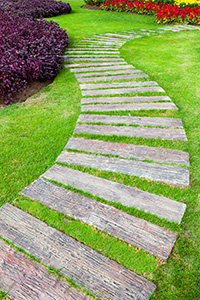Create a Pathway Using Railway Sleepers

If you have a path that’s in regular use – usually to a shed or pergola – it can have an impact on your grass quality. Creating a path is an excellent way to break up your lawn and offer an easy way for people to get around the garden without ruining your lawn. Sleepers are extremely hardwearing and versatile, and perfect for laying garden paths. Unlike gravel paths, you can easily walk on them barefoot and they won’t heat up like stone or concrete pathways.
The best thing about using railway sleepers is that they are easily cut and you don’t really need much expertise – just a strong back and a little inspiration.
A Simple Garden Sleeper Pathway

The simplest sleeper pathways just involve digging and arranging the sleepers where you want them:
- Place the sleepers where you want them to be in your garden – make sure that they’re not too far apart to step from one to the other, but you don’t want them so close together that you might trip up either. Around 300mm apart us usually ideal.
- Mark out their positions using chalk.
- Measure your sleepers and dig deep enough so that the sleeper is mostly submerged with 25mm above ground level.
- Pour 25mm of sand into each hole and tamp it down.
- Slowly place a sleeper into each hole, using a sledge hammer to tap it down and level it out.
As the sleepers settle, they’ll sink down a little further so if they look like they’re protruding a little too much don’t worry – they won’t look like that for long.
Your Pathway Options

If you’d like something a little more sophisticated, you can dig out a larger section of your garden to fill it with gravel or pebbles and add sleepers to walk on comfortably within that path. Another option is to dig out the whole area and use sleepers to fill it entirely, like you would with paving. This option would require a lot more effort to stabilise the sleepers since they’re likely to push at the earth around them or move against each other.
The simple pathway above is often the best option for a low maintenance path, especially if you have a smaller garden. If you have a larger area and don’t mind a more intensive project, the possibilities are endless.
